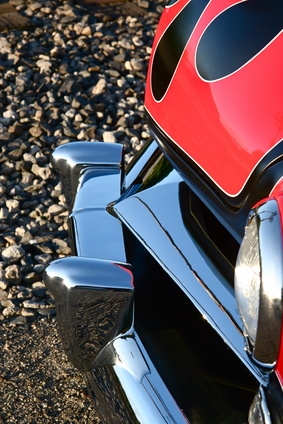
Automobile car bumpers have the important function of lessening low- or high-speed impacts from the front or rear of the vehicle. Numerous designs come equipped on various makes and models with different components and features. Yet they all serve the same function: protecting the occupants of the vehicle from traumatic shock during a collision or lessening body damage to the vehicle by absorbing collision force. Some bumpers have extremely technical features and designs.
Sometimes called bumper "lug nuts," the mounting bolts used for securing the steel bumper frame to the chassis, have extremely heavy construction, with large-diameter bores and coarse threads. Typically made of high-tensile steel, the bolts have thick spacers and locking washers to secure them in place. Some vehicles can have as few as four mounting bolts, while others might have up to 10 or 12.
The bumper frame, typically made of steel, stretches from one side of the vehicle to the other, making it the largest and heaviest piece of all the bumper components. The bumper frame sits between the vehicle chassis and the outside bumper cover, serving as the main impact component. On older vehicles, the bumpers were designed to crush completely upon impact; they had extremely heavy construction and often had chrome plating.
Bumper brackets come in a variety of shapes and sizes for the different makes and models. Cast of angular steel, the brackets connect the bumper frame to the vehicle chassis frame. Some cars have two large adjustable brackets on each end, whereas heavier trucks might have four. Bumper support rods, made of solid steel rod, connect the chassis frame to the outside ends of the bumper frame and serve as extra braces. They guard against outside angular impacts, where the bumper end can become crushed or forced inward.
Crush cans and absorbers function as impact dampeners that mount between the bumper frame and the chassis. They can incorporate thick fiber pads, rubber bushings, high-impact plastic or polystyrene. Their design allows them to crush or give upon impact, allowing the bumper frame to flex inward with minimal damage.
Bumper guards, usually two rectangular rubber blocks that sit near each of the bumper's outer ends, serve as the first impact components on the bumper. Constructed of pliable, solid rubber, the bumper guards bolt to the bumper frame---usually with two bolts. Bumper guards extend outward from the bumper surface as much as 4 to 6 inches, which ensures that they make contact with an object before any other bumper component.
Many foreign-make and newer vehicles come equipped with shock tubes mounted between the bumper and the chassis, instead of using the crush can or absorber. Some bumper shocks have spring-loaded tubes that allow high impact, allowing them to rebound when struck. The entire bumper can travel backward with the impact and rebound back into position. Some bumper shocks function with gas or hydraulic-operated tubes, performing the same function as the spring-type bumper shock.
Instead of using protruding solid bumper guards, some car and heavy truck bumpers come equipped with inset bumper trim strips constructed of high-impact polyethylene plastic. The trim strip extends from one end of the bumper to the other, usually bisecting a chrome bumper through the middle. Extending 1/2-inch or so outward from the bumper face, the trim strip makes first contact with any object, protecting the finish of the bumper. They also serve as decorative trim pieces.
Bumper covers, constructed of high-impact plastic or rubber, usually have one-piece designs that bolt or screw onto the bumper frame. They serve as the covering or outer shell of the entire bumper surface, and sometimes match the color of the vehicle. They can be insulated with foam, or consist of solid, molded pieces. Primarily designed to serve as the bumper's decorative outside covering, they provide a minimal amount of impact protection.
Some bumpers have mounting holes and brackets for lower turn signals and fog lamps, along with mounting holes for license plate brackets.